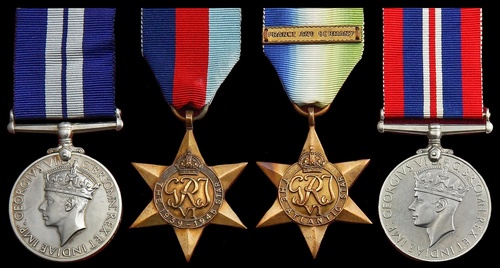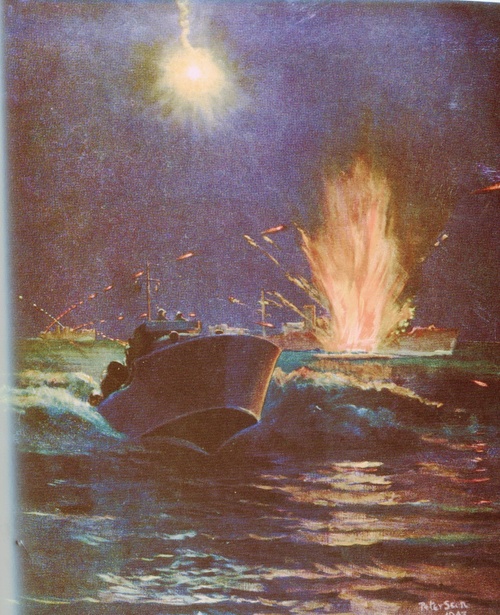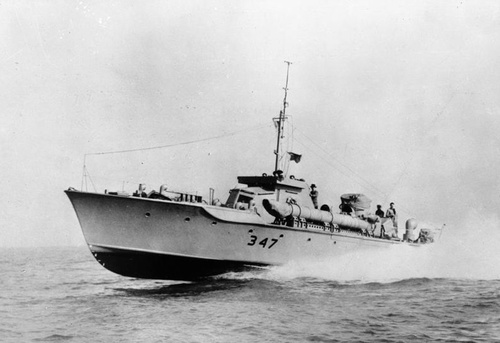Auction: 17003 - Orders, Decorations and Medals
Lot: 680
'If the occasions which call for fortitude and courage in an M.T.B. action are related in any way to victory or defeat, it is often in inverse ratio, for it is in adversity that those qualities in the human spirit shine most brightly. In the autumn of 1944, however, a battle was fought in which great boldness well-earned the success it deserved, although not without cost, both in men and boats, and fortitude and courage were called for in full measure. Most of the action took place during one fiery hour between half-past midnight and 1.30 a.m. on the morning of 1st October, when five of our M.T.Bs. made their attack on an escorted convoy coming towards Ijmuiden from the south … '
The Battle of the Narrow Seas, by Lieutenant-Commander Peter Scott, M.B.E., D.S.C., refers.
The outstanding Second World War Coastal Forces D.S.M. group of four awarded to Stoker L. G. Sykes, Royal Navy, who was decorated for his gallantry in M.T.B. 347 in 'a battle as full of the colour and essence of M.T.B. warfare as any which was ever fought in the Narrow Seas'
Distinguished Service Medal, G.VI.R. (Stoker 1 G. Sykes, P/KX. 163409); 1939-45 Star; Atlantic Star; War Medal 1939-45, generally good very fine (4)
D.S.M. London Gazette 23 January 1945:
'For outstanding courage, skill and determination in attacks on enemy shipping while serving in light coastal craft.'
The original recommendation states:
'During the action on the night of 30 September-1 October 1944, he descended several times into the damaged engine room, which was full of noxious fumes, without a breathing apparatus, to plug a hole in the bottom of the boat; and later, in repeated attempts to restart the engine.'
Geoffrey Sykes, a native of Drighlinton, Yorkshire, was serving as a Stoker in M.T.B. 347, under Lieutenant A. D. 'Alec' Foster, R.N.V.R., at the time of the above cited action.
M.T.B. 347 was one of five boats from Felixstowe's 11th Flotilla to participate in this celebrated action, fought off Ijmuiden in the early morning hours of 1 October 1944. It proved to be the mother of firefights, the M.T.Bs. jumping a heavily defended enemy convoy at about half past midnight.
As related by Peter Scott, Foster's boat took her first major hit in the early phases of the action, when she followed up the Flotilla's initial attack with M.T.B. 350, under Sub. Lieutenant H. G. Franklin, D.S.C., R.N.V.R. Of the damage sustained by Foster's boat, the Flotilla C.O. later reported:
'A 3- or 4-inch shell tore a large hole in the starboard torpedo-tube, cracking the air bottle of the torpedo; it also blew the after Oerlikon gunner over the side and wounded two other gun's crew ratings. Smaller calibre shells hit the port torpedo-tube, bridge, mast and Oerlikon ready-use locker, setting a pan on fire. At 0040 opened fire on trawler to starboard with after Oerlikon, many hits been seen on the bridge and superstructure. Range of vessel 800 yards. Passed order to fire torpedoes to M.T.B. 350, who did not receive the order. Both tubes in 347 failed to fire. The seaman torpedoman on the port tube reported the breach block was damaged and unable to be fired; the starboard tube was obviously useless …'
Foster's immediate consort - M.T.B. 350 - carried on the attack and gained two torpedo strikes, prior to stopping to pick up survivors from M.T.B. 360, which had been set ablaze by accurate enemy fire. Peter Scott continues:
'Franklin's determination in pressing home his attack to 500 yards in the face of such opposition was beyond all praise. No less remarkable was Foster's continued approach after his boat had been hit, in the hope that the second torpedo might still be able to be fired.'
Foster's boat was by now in a sorry state. His Flotilla C.O.'s report continues:
'At 0041 M.T.B. 347 was hit in the engine-room. One 3- or 4-inch shell exploded on the after end of the central engine, blowing down the engine-room tiller-flat bulkhead, lifting the deck off the tiller-flat, making a large hole in the bottom of the boat below the centre engine, damaging the auxiliary engine, and assisting the centre engine Dumbflows through the port side of the boat. A few seconds later another large shell hit the starboard engine, and smaller shells struck the port engine outboard exhaust manifold and damaged the electrics. The steering gear was put out of action, and the C.S.A. gear [smoke making apparatus] and other upper deck fittings were removed. The Motor Mechanic, with a shell splinter in his shoulder, was the only casualty from these hits. The Motor Mechanic ordered the engine-room, which was full of exhaust fumes, to be cleared. Bunk cushions were brought aft and attempts were made to plug the hole in the bottom of the boat by the engine-room crew, while holding their breath, as the smoke helmet had been blown away … '
In such circumstances, Foster would have been fully entitled to withdraw from the scene of battle. Instead, as related by his Flotilla C.O., he returned to the fray:
'At 0200 two explosions and columns of water, followed by a cloud of smoke, were seen on a motor vessel, which was now about a cable to port. M.T.B. 347 proceeded at about 4 knots on the inboard bank of cylinders of the port engine, and on hand-steering, course south-east. At 0045 crossed bow of a trawler which was burning fiercely aft. Oerlikon fire was opened on this ship at 100 yards' range and many hits were seen on her bridge, which was left burning. Her return fire hit M.T.B. 347 forward, causing her to make water in the forward heads. This leak was stopped with mattresses. At 0046 the helm was put hard a-starboard to bring the boat on a reciprocal of the enemy's course.'
347's ordeal was far from over:
'Unfortunately the rudders jammed in this position. The boat circled slowly, completely out of control, and struck the next enemy in the line a glancing blow amidships with her port bow. This ship was a minesweeper with sweep out aft and flying a balloon. She was firing on both quarters and did not appear to see M.T.B. 347. As the Oerlikons were being reloaded by the one remaining gunner, and in view of the extreme proximity, the Commanding Officer decided not to attract her attention by firing the .303. While circling away the steering gear was freed and the boat was brought to the reciprocal of the enemy's course. As she drew clear of the minesweeper, she was hit on the starboard bow by a large shell, presumably fired by one of the inshore escorts. This escort opened inaccurate fire on M.T.B. 347, but a small fire was started in the wheelhouse. This was extinguished at once. About this time three trawlers were seen to port, range about 1,000 yards. Two minutes later the next enemy in line, a small tug, was abeam range 75 yards. She was engaged and heavily hit on the bridge by the Commanding Officer, who had manned the after Oerlikon. Fire was then switched to another dark shape, which was now abeam, range 250 yards. The remaining rounds in the pans, about ten in all, were fired, but no hits were seen. This target was silhouetted and seen to be a large destroyer. Fortunately she did not open fire. By the time M.T.B. 347's guns were reloaded, she was no longer visible and no other ships could be seen.
During these actions a fire in the engine-room had been reported and the methyl-bromide extinguishers had been released without success. The time was now about 0055 and a burning wreck was seen to the west. A south-westerly course was steered to clear this, as its identity was not known. The R/T receiver was still working and the Senior Officer could be heard calling M.T.B. 347 up. The aerials were re-rigged and attempts were made to answer, without success. At 0110 the port engine stopped, and the engine-room crew tried hard to restart again while holding their breath. Water was now over the starters and their efforts were in vain. At 0120 the boat began to settle by the stern, and after ordering the wounded to be put on the raft and confidential books to be sunk, the order was given to abandon. At 0130 M.T.B. 347 sank by the stern and disappeared.'
The raft was eventually found by Lieutenant F. W. Bourne, D.S.C., R.N.V.R., the Flotilla C.O., in M.T.B. 351, and 347's gallant survivors were embarked for Felixstowe.
As Peter Scott concludes in Battle of the Narrow Seas, 'by their spirit in this battle alone' the names of Alec Foster and Henry Franklin - and their gallant crews - will long be remembered in the annals of Coastal Forces; so too Geoffrey Sykes, whose fortitude in the carnage of 347's engine-room defies belief. No wonder he was awarded an immediate D.S.M.
Subject to 20% VAT on Buyer’s Premium. For more information please view Terms and Conditions for Buyers.
Sold for
£3,500









